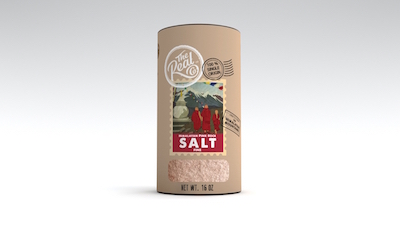Salt from the Celtics to Sinkholes
Even the word itself has salted our language from biting or “salty” dog language to the invigorating briny – or salubrious” smell on our skin after an ocean swim, “salubrious”- or “healthy” derived from the Latin for “salt.” So is “salami” (salted meat), “salary” (from wages paid to Roman soldiers) and even “salad” (the bitter taste of salted greens).
A juicy piece of gossip is “salacious” because ancient Romans in love were ‘salted.’ And salt is often linked to fertility and sexual desire, as well as to abundance (thus the timeless gift of salt and a loaf of bread to new homeowners) and conversely to drive out evil spirits, as often seen in front of Asian restaurant.
Salt, the only rock we eat, is required by all animals in their diets. Both the sodium and chloride in salt, classified as electrolytes, are essential nutrients which help regulate the body’s fluids and keep our muscles moving, including the heart. It actually conducts electricity in the body, transmitting signals to muscles and nerves. Yet, astonishingly, a person even deadly deficient in sodium will not crave salt –unlike a starving man delirious for food.
But these are only a few of the fascinating elements in the history of salt that reveals as much about socio-economic and political history as the nature of our palates.
Clear or white, brittle mineral salt contains the elements of sodium and chlorine. Its chemical formula is NaCl; its mineral name is halite. Salt forms clear, cube-shaped crystals though impurities can cause it to appear white, gray, yellow, or red. All salt deposits began as salty water; brine from seas, oceans, and salt lakes, even the solid deposits in the earth which are collected or mined. Salt can be mined from underground supplies or salt crystals can be collected from dried out salty springs and lakes or by tapping underground supplies. Salt is then extracted from sea water by boiling or leaving it to evaporate.
Archaeologists track humans eating of salt to 10,000 BC, along with animal domestication and farming. Chinese historians recorded salt harvest by 6000 B.C. and can rightfully boast they were the forerunners of almost every form of salt harvesting. Around 2000 B.C. came the realization of salt’s necessity —to keep food from rotting –at about the same time it was used to wrap mummies in Egypt.
The ancient Chinese, Egyptians, bigger than life warrior-farmer-inventor Celts and Romans British discovered how to extract and transport salt but in short supply, making salt trade vital. While the myth of salt being worth its weight in gold is exaggerated, albeit only slightly, salt was used as currency in Mediterranean and Asian salt trading centers.
If you look at a current map’s squiggly, seeming unplanned lines today, they are actually animal trails to salt licks that grew into paths and then roads. Salt became so valuable it influenced the establishment of trade routes and cities, provoked and financed wars, secured empires, and triggered revolts through tax levies –including the American Revolution – and armies starved due to lack of salt, a factor well known by Napoleon in Russia and confederate generals during the Civil War.
Up through the 19th century, salt was primarily used to preserve meat, fish and vegetables, regulate fermentation, and to create delicacies such as salted olives for a more varied diet. Versatile salt was also used to treat leather, dye textiles and in making pottery. Today’s salt industry boasts 14,000 uses of salt including the manufacture of pharmaceuticals, deicing roads, fertilizer, soap, water softeners, glass and textile dyes, natural healing (still the best and the cheapest for soaks and gargles).
Salt consumption probably peaked in Europe in the 19th century when people ate as much as 18g a day, just when salt shortages effectively ended. Not only the discovery of vast salt fields but when refrigeration, tin cans and packets revolutionized eating habits. In 1925, an eccentric inventor named Clarence Birdseye created the first frozen seafood company and was soon selling a million pounds of product annually.
This meant food need not be salted, a fact well known by the Lapps, Bedoins and Masai, who consumed all the sodium they needed from their animal and fish diet. On this continent, hunters in Greenland ate no salt until they were introduced to it by 17th century European whalers.
Ah, but the taste! Most of us consume twice the recommended daily amount of sodium — 2,300 milligrams, or about a teaspoon of salt — despite the `overwhelming evidence” that excessive sodium intake is tied to hypertension, heart disease and stroke though the word “excessive” remains elusive. Why? Salt provides an appealing taste enhances color, texture and `mouth feel” in foods. And it helps counter bitter tastes.
Nevertheless, salt is again fashionable: French grey salt and fleur de sel (flower of the salt in French) are best sellers and Salt has even become a celebrated showpiece on restaurant tables from salt-encrusted entrees to foods presented on a bed of salt. In Lezhi, the old fashioned method making soy sauce, developed simply as fare for workers on the job, has become a prized artisan delicacy.
The long, winding and intriguing history of how salt has shaped civilization from the very beginning has been beguilingly told by Mark Kurlansky in his book: SALT. Populated by colorful characters, wild tales and fascinating details this supremely entertaining, multi-layered masterpiece will never allow anyone reading it to take salt for granted again.
A more humane and much more fun tribute to salt and the history it represents is the brand new salt and pepper cellar museum in Ohio — with over 30,000 shakers on the walls.


 Gerry Furth-Sides
Gerry Furth-Sides  Barbara Hansen
Barbara Hansen  Chef-owner Alain Cohen
Chef-owner Alain Cohen  Roberta Deen
Roberta Deen  Jose Martinez
Jose Martinez  Nivedita Basu
Nivedita Basu